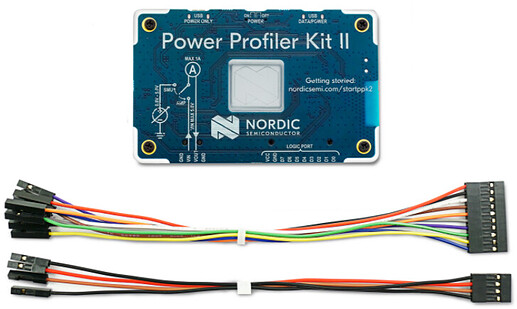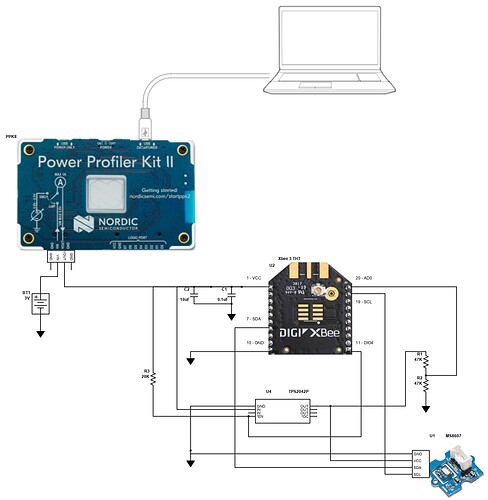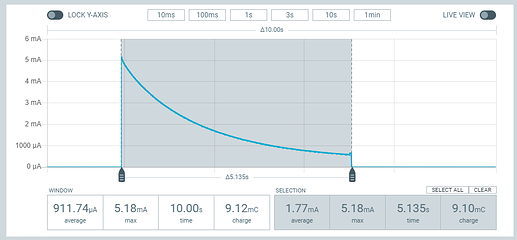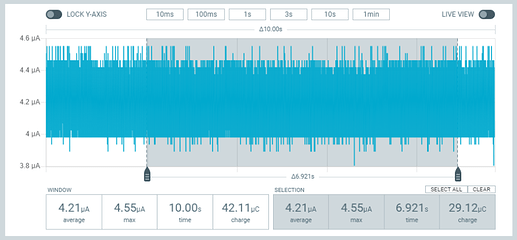Battery powered wireless IoT sensors typically sleep much of the time to minimize current consumption and maximize battery life. The sensor’s current consumption needs to be determined in order to estimate battery life. Nordic’s Power Profiler Kit II is an excellent tool that can be used to measure a device’s current during active and sleep modes.
Description
The type and size of the battery used in a device along with it’s average current consumption is needed to estimate battery life of the device. Battery powered sensors typically cycle between sleep and wake modes to minimize average current consumption. This project uses Nordic Semiconductor’s Power Profiler Kit II to measure average current of an example wireless sensor during it’s wake and sleep periods. Detailed information on the sensor used in this project can be found at: Machinechat with Battery Powered Xbee3 Wireless Zigbee MS8607 Environmental Sensor.
Hardware
- NRF-PPK2
Nordic Power Profiler Kit II - The PPK2 supports dynamic current measurements from 200nA up to 1 A and can be used to supply a connected board as well as measure its current. For the ampere meter mode, an external power supply must source VCC levels between 0.8 and 5V to the device under test (DUT). For the source mode, the PPK2 supplies VCC levels between 0.8 and 5V and the on-board regulator supplies up to 1A of current to external applications. The PPK2 can also use digital inputs as a low-end logic analyzer, enabling code-synchronized measurements.
Software
- nRF Connect for Desktop
nRF Connect for Desktop is a cross-platform tool framework for assisting development on nRF devices. It contains many apps to test, monitor, measure, optimize and program your applications.
Power Profiler (App in nRF Connect for Desktop)
This App operates in conjunction with our Power Profiler Kit. It lets you read, analyze and export measurements from the Power Profiler Kit.
Background
The wireless IoT sensor used for this project is the circuit in Machinechat with Battery Powered Xbee3 Wireless Zigbee MS8607 Environmental Sensor . To minimize it’s current consumption it is configured as a Zigbee End Node that sleeps for 60 seconds and then wakes to make it’s sensor readings and transmit to the Zigbee Coordinator node.
The wireless sensor is powered by 2 AA alkaline batteries in series, providing a nominal 3 volt supply voltage. Below graph shows the nominal capacity of a AA alkaline cell.
Figure 1. AA/LR6 alkaline battery capacity to 0.8 volts (source: Energizer - Alkaline Handbook)
Battery life is estimated by dividing the nominal battery capacity by the average current that a load is drawing from it. Battery capacity is typically measured in Amp-hours (Ah) or milliamp-hours (mAh) and average current is by determined by calculating the average current in a sleep/wake cycle period.
Digi-Key provides an on-line conversion calculator that provides an easy tool for estimating battery life, Battery Life Calculator.
The battery pack provides a nominal supply voltage of 3.0 volts. Recommended supply voltage range of the IoT sensor’s radio and temperature/humidity sensor is shown below:
| Xbee3 | MS8607 |
|---|---|
| 2.1 - 3.6V | 1.5 - 3.6V |
The value for nominal battery capacity can be estimated from the below Energizer AA battery capacity graph.
Figure 2. AA/LR6 alkaline battery being discharged at 100mA to a 0.8 volt cutoff (source: Energizer - Alkaline Handbook)
Available battery capacity can be calculated by multiplying the drain rate (mA) by the hours to the specified cutoff voltage. For example, the AA/LR6 battery shown in the above graph would have a capacity of (100mA X 25 hours) 2500 mAh under a 100mA drain to a 0.8 volt cutoff. The minimum supply voltage for the IoT sensor used in this project is 2.1 volts (2 x 1.05V) so the capacity to a 1.05 volt cutoff for the AA/LR6 battery under the same 100mA drain would be about (100mA X 21 hours) 2100 mAh.
Test setup, measurements and results
For this project, the PPK2 is configured in ampere meter mode and wired in series with the battery pack and VCC of the IoT sensor. Refer to Nordic’s Power Profiler Kit II User Guide for instructions on setting up the PPK2 hardware and using the Power Profiler GUI. Below schematic diagram illustrates how the PPK2 and IoT sensor are wired up for the test.
![]()
PPK2 and IoT sensor test setup Scheme-it schematic and BOM link
Below PPK2 screenshots show the IoT sensors current consumption.
Figure 3. IoT sensor current measurement
Figure 4. IoT sensor wake average current measurement
Figure 5. IoT sensor sleep average current measurement
Based on above measurements, average current during a wake period is 1.77mA over a duration of 5.135 seconds and average current during a sleep period is 4.21uA over a duration of 60 seconds with a total wake/sleep cycle period of about 65 seconds. This calculates to an approximate average current of 0.142mA. Based on battery capacity of 2100 mAh (to a cutoff supply voltage of 2.1V), battery life of the IoT sensor is estimated to be about 1 year and 8 months.
Conclusion
Nordic’s Power Profiler Kit (PPK2) makes it easy to measure a devices average current in sleeping and active modes. Once average current consumption of a device is determined, it is a simple exercise to calculate an estimate of the device’s battery life. The PPK2’s low cost, wide current and voltage range, easy to use GUI, and thorough documentation make it an indispensable tool for anyone wanting to better understand a devices power consumption.







